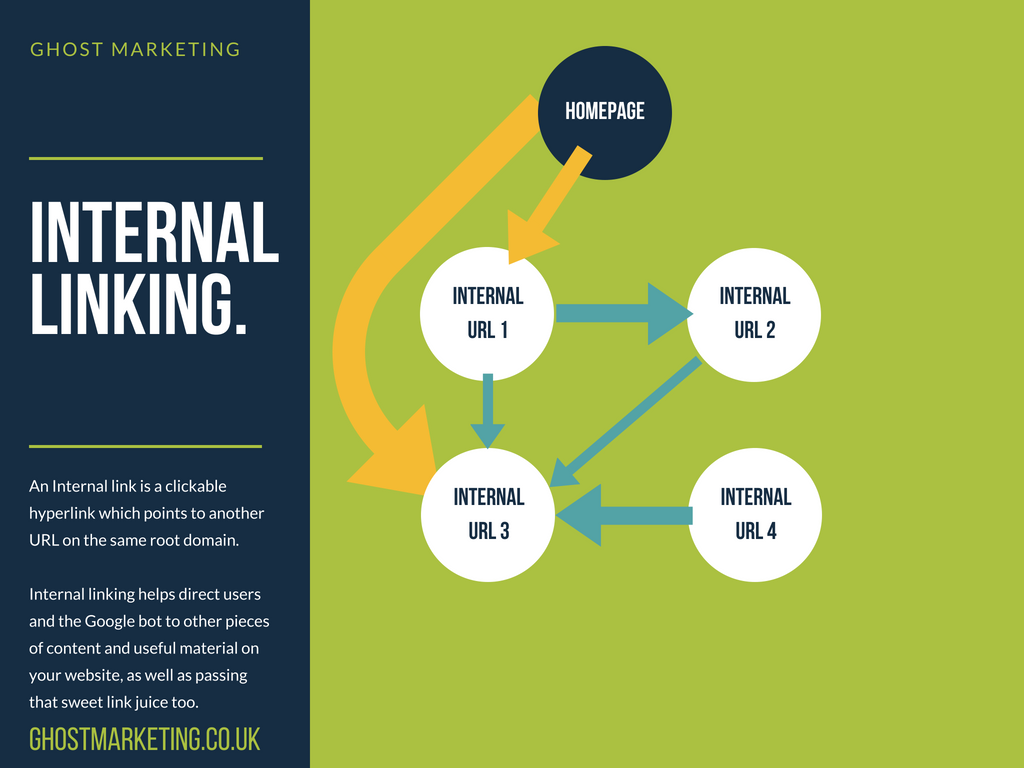Internal linking is one of the single most under utilised link building strategies. Although strictly speaking not an inbound link generation strategy, internal linking can be incredible effective and profitable for your website.
Implementing a few dozen internal links can help direct link juice to the correct places, as well as helping Google to categorise your site in terms of posts you want to rank, importance of post or content type and what that piece of content is about.
In this post we’ll be breaking down exactly what internal linking is, why it matters and how you can implement an internal linking strategy on your site to generate some positive organic increases.
Contents
What Is An Internal Link?
Simply put, an internal link is when a URL on a domain links to another URL on that same domain through a specific anchor text. This is exactly like a normal backlink but instead of linking to another site, it’s simply a different URL on the same root domain.
Why Do They Matter?
Internal links are incredibly important for 2 core reasons.
The first is internal links help users navigate a site, can you imagine how difficult it would be to find a specific category of product on Amazon without the use of internal links? Or how frustrating a large commercial site would be to navigate without a menu bar?
But aside from user experience and obvious ease of access of a site, internal links actually help crawlers analyse what each particular page is about, as well as how important each page is. And hence, the second reason why internal links are so essential – They help specific pages rank for specific profitable keywords.
Not All Internal Links Are Created Equal
To help simplify this concept I’m going to split up 2 types of internal links.
The first is your menu, sidebar, navigational type internal links. This is what you would expect to see on Ecommerce stores, large enterprise style websites and essentially it’s a way users can navigate the site in a more efficient way to get information or find out more about what you are selling/offering.
The second (more important type from a ranking perspective) is the internal contextual links. These are the links that point from a piece of content/text or page that aren’t navigational. I won’t dive into this in too much detail as I’m sure this is very basic for a lot of people reading this post, but contextual links are much more effective at passing link equity (aka rankings) than menu/navigational style linking.
In short, throughout this post we’ll be talking in terms of internal contextual linking to enhance organic visibility and user experience will take a back seat.
What Is Link Juice?
Link juice is a relatively old, slang phrase used by the SEO industry to determine link power, equity or “juice”. AKA how much weight a link carries, the more weight or juice, the more it will improve organic rankings.
Link juice in regards to internal linking simply means where the link juice flows. If for example you have a piece of content that has 4 internal links to other pieces of content (and say 6 external links), the link juice/equity that comes into that URL will actually move through the post and “flow” to those other 10 links on the post. 6 of which will pass “link juice” or power to those other URL’s and 4 will pass “link juice” or power to the 4 internally linked posts. Image below from woorank.
Previous research shows the more links you have on a page, the less powerful each individual link becomes, meaning if possible you’ll want to reduce the number of external links you have on a post. Although this research is correct and has been tested multiple times, it’s also very old. There’s a few key things to remember when taking this data on-board:
- External linking is actually a slight positive ranking factor.
- From a user experience point of view external links are straight up helpful.
- Google now looks at the “impression” of a site and not individual ranking factors on a weighted average basis. Meaning if you can get a link alongside 100 industry experts, although that individual link may not carry a lot of value (from a link juice point of view), it actually adds a lot of credibility to your site in that specific industry being seen alongside these other authorities.
Why I Love Internal Links!
Simply put, the results internal linking campaigns can generate!
Link building itself is a very time intensive (or resource intensive) marketing strategy. It’s incredibly effective, but it does take time and can cost a lot from content curation, outreach, content writing again, graphics, prospecting etc.
Internal linking on the other hand is extremely fast to implement, you can implement an entire internal linking strategy in one day and have the organic improvements once the site is re-crawled.
Internal linking gives all the control to you, meaning if you have a page that needs some link juice, instead of implementing a backlink generation campaign that can be very time and resource heavy, you instead build out an internal linking strategy for that page (linking to it from other high-power pages that already have link juice).
The results are always positive! (As long as you don’t make any mistakes)
In 25+ full internal linking strategies we’ve implemented in the past 12 months, every one has resulted in an increase in organic rankings for the core target search terms that were pre-determined….. This brings me nicely onto my next point.
How To Build An Internal Linking Strategy
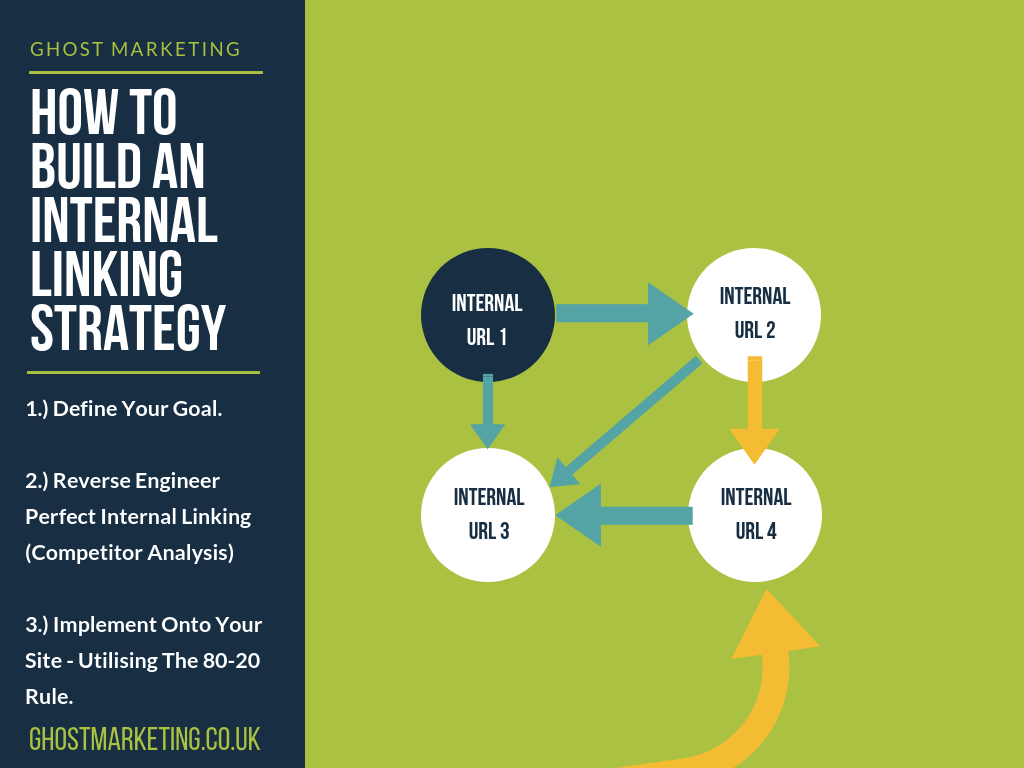
Stage 1: Determine the Desired End Goal
- Do you have keyword cannibalisation & want to resolve this?
- Do you want to push keyword rankings for a few primary terms or pages?
- Is your site architecture messed up?
- Do you want to implement a full internal linking campaign across the entire site?
These goals are all very different, meaning the structure of an internal linking campaign will be very different and key elements will change depending on the size of your website, your goals, type of site (blog, publication, Ecom store etc).
Before starting an internal linking campaign be sure to determine the end goal you want. 95% of the time this is going to be increased organic rankings for the site (and potentially with a focus on some specific landing pages/terms.) But in some cases there may be some more specific elements you are looking to solve. Before starting the analysis, decide what you are looking to achieve.
If you don’t know where you’re going, you’ll never get there.
Stage 2: Reverse Engineer Perfect Internal Linking (Competitor Analysis)
This stage involves finding what’s already working in Google and simply analysing what your competitor are doing better than you.
We use a number of tools to implement this and the entire strategy for doing this can be seen below in more detail, but a refined version is simply:
- Analyse your top ranking digital competitors.
- Find the core 5 “golden” keywords they rank for.
- Implement these into a specific strategy, utilising multiple different softwares (more on this later). Averaging out the top 3 ranking competitors anchor text ratios.
Stage 3: Implement this into your site correctly
Self explanatory, but implementing the correct strategy onto your site, focusing on where the largest opportunities are.
For larger sites you really should not overlook or skim this internal linking strategy. It’s one of the easiest ways to get a very large increase in rankings, across the board when implemented correctly. Later in the post we’ll get into 2 methods on how to actually implement this.
Moving onto why internal anchor text is so important.
Internal Link Anchor Text & Why It Matters
We touched on this briefly above but it’s an incredibly important topic as it’s quite misunderstood even by a number of experts in the industry.
The general consensus when building internal links is to vary the anchor text. For example if I wanted to build 10 internal links to this post I would want to make every internal link unique: “internal linking guide” “internal links info” “anchor text for internal linking” etc etc.
If this were building external links I would 100% agree but these aren’t…
In certain situations it’s important to refine your internal linking anchor text and actually build multiple links with the same exact anchors….
Internal Linking Case Studies – 2 Detailed Methodologies
Why and when is this the case?
Please don’t take the above as a statement that you can go and build dozens of internal anchors with an exact match anchor for your primary term. There are situations when this is the case, and the easiest way to determine this (as always) is to see what is already working and reverse engineer those competitors.
Internal Linking Case Study One: Wordstream’s Link Building Page
Wordstream’s link building page ranks 4th for the term “link building” and incredibly broad, competitive search term. But Wordstream itself is a brand that covers quite a wide range of content marketing, paid, search and digital marketing in general. I believe their main focus is actually paid advertising. So how are they ranking 4th for such a high level term?
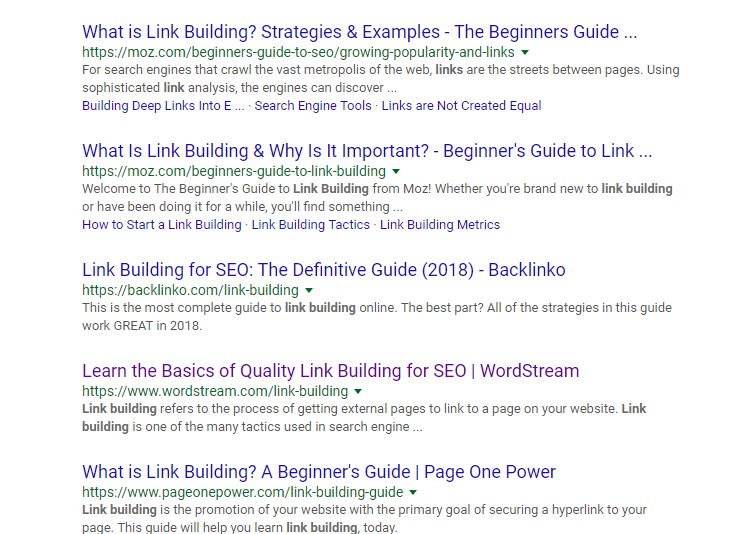
The guide itself is also quite short and not exactly the best piece of content on link building…
But looking into their external and internal linking we can see one large reason why they rank so well.
For their external linking anchor text we can see they have a heavy exact match percentage, obviously this screenshot is from Ahrefs (which we’ll get onto in a second in regards to our “quick wins internal linking strategy”).

But this is a competitive search term so that’s to be expected.
What’s more interesting is their internal linking.
Using screamingfrog we can take a quick look at the internal links pointing to this page, what’s interesting to note is that all the internal links pointing to the link building page have a very high exact match primary keyword “link building” percentage.
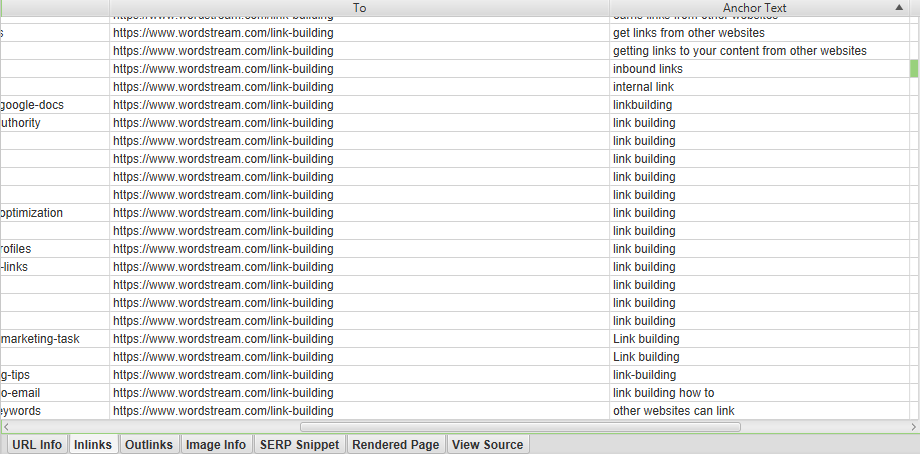
The reason why wordstream can get away with so many exact match internal anchors is twofold. The first part is that link building itself is actually a short phrase in a very competitive space, this means that competitors (and Google) expect the percentages to be higher than if the keyword were 4 words long and hyper specific “resource page link building” for example.
Note: This is extremely common in hyper competitive niches (car insurance, credit cards, payday loans) for example have a 70%+ exact match internal anchor text ratios.
Internal Linking Case Study Two: “E liquid & Vaping Terms”
For the second example I wanted to take a different type of site (eCommerce) in a very different niche (vaping). The term we’re going to use for this, is the very profitable and competitive “e liquid”. For the US market. Below is a screenshot of the two sites we’ll be analysing for this example.
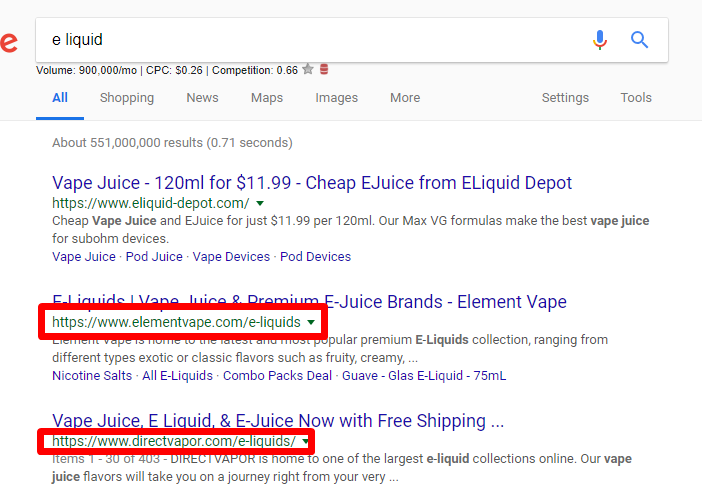
900,000 monthly search volume worldwide. Tough niche but a golden “champagne” keyword as we call it in-house.
What we’re looking for here is the distribution of internal links and what specific anchors these top couple of competitors have, once we know this we can then simply reverse engineer this in the same way.
Some general assumptions in the above example would be: to target this term we want to rank an internal page (domain.com/e-liquids/) – We’re not going to re-invent the wheel here. Something we see alot is individuals trying to build campaigns or site-structure documents from scratch. In my opinion that’s a huge mistake. Simply look at what already ranking in the top 5 results for your primary keywords and reverse engineer that site structure. K.I.S.S.
From here we want to find out the exact internal anchor text ratios that this specific site uses.
There’s more on my internal link juice tool of choice below (an entire guide). In this example we’ll use sitebulb.
As well as analysing one competitor, I’d recommend combining the results from 2-3 of the top ranking competition, but this example I’ll use the #2 ranking competition and reverse engineer their results.
Similar to our above example, we’re looking at what & where the anchor text is pointing to, and which URL to determine what that specific URL should be ranking for.
The more profitable the page, the more internal, keyword-specific anchors you should have pointing to this page.
In our vaping example, the number of internal links pointing to the /e-liquids/ page was in the 100s, with the target anchor phrase being used 92% of the time.
The issue is the majority of these are internal links in the sidebar/menu section of the site, which if you’re not familiar carry a lot loss weight in terms of rankings than contextual links.
Even the external anchors are very exact-match rich.
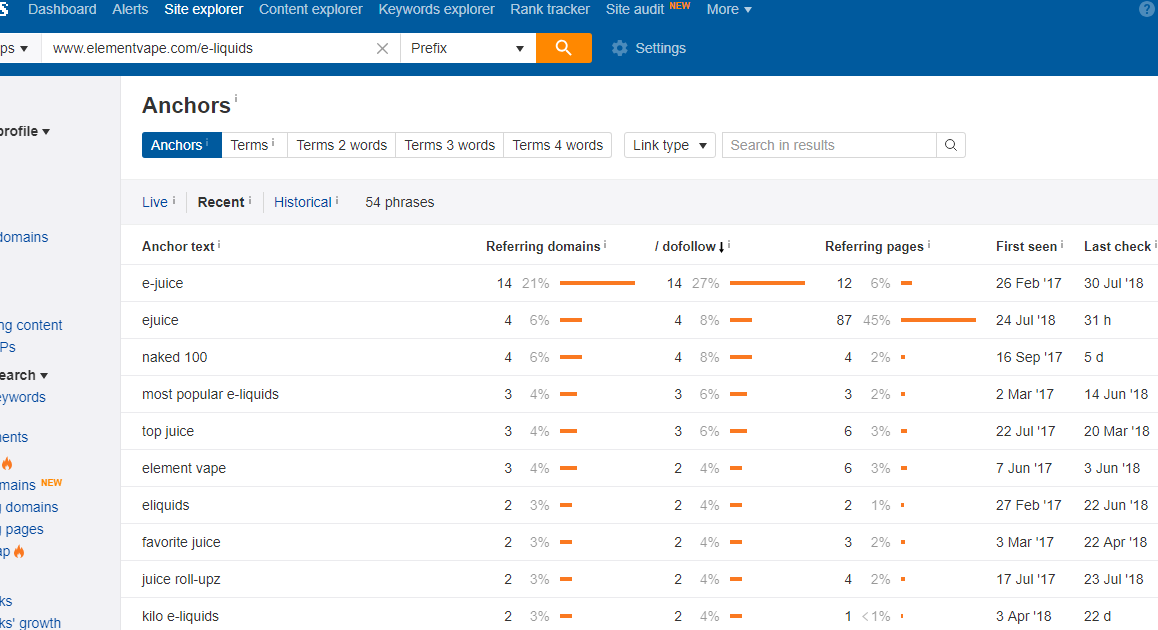
So what does this tell us about the niche & specifically the search term?
The answer is it’s able to hold a lot more exact-match weight in the SERPs. Meaning if you build 10 links, 5 of which can be variations of the exact match term (plurals, variations, juice/liquid rotation etc would be advised.) and you’d still rank for this term without becoming over-optimised.
My Internal Link Juice Tool Of Choice
I say tool, there’s 3 we like in-house. These are Ahrefs, screamingfrog and sitebulb.
All serve a very different purposes and have unique elements that are very beneficial.
As most people know already, Ahrefs is one of the best tools for anything link building related. For internal linking you can save a ton of time implementing strategies for larger sites (this is discussed in our quick-wins strategy below).
Sitebulb has some really awesome visual features that can be implemented. These are called their crawlmaps and are a very visual, strong USP for their company.
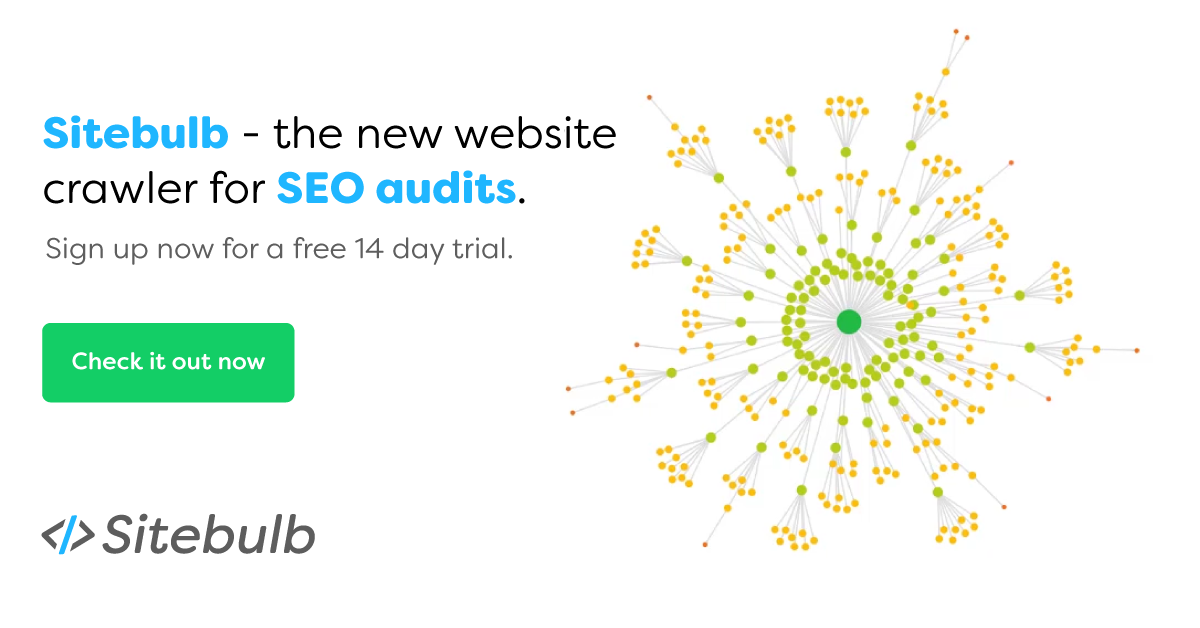
Screamingfrog has just been around for so long that everyone in the world can use an implement strategies on this, if that’s your go-to, then they have a very good internal linking feature.
Internal Linking Quick-Wins Strategy
Let’s say you’re pushed for time, under-resourced and just looking for the 80% results for the 20% time input. First up, that’s 90% of what search marketing is about. Second, let’s take a look at some really easy internal linking strategies that we can build out and implement in less than a few hours to generate some great results without any additional costs.
1.) The Ahrefs – Super Streamlined Strategy
Ahrefs is the best seo software on the market, potentially the best marketing software nowadays too (not affiliate in any way). Using their big data in an efficient way can generate massive increases in organic search. In the below example I’m going to explain how we implement our internal linking quick wins strategy for larger clients.
Part 0 – Define What Your Goals Are
As mentioned above, what are you looking to achieve from the internal linking campaign?
In this example I’m going to assume it’s to increase the rankings of all primary commercial webpages. We’re going to do this in the following way, which is the most efficient way if you are short on time.
Part 1 – Throw in your domain.
Pretty simple, throw in your domain into site explorer and hit the orange button. For this example I’m going to use the Men’s clothing store TM Lewin, again no affiliation. As you can see it’s a large site with 2.4k referring domains, ranking for 56,000 keywords. Not bad.

Part 2 – Identify Top Pages & Filter
Next we want to go to the “top pages” section of ahrefs, here we’re going to identify the top pages from both an organic rankings point of view, as well as from a referring domains point of view.
Depending on the number of results (and the amount of time you have) you’ll want to use the Ahrefs filters to get the top 20% of URL’s that will result in 80% of the organic movements once internal links are implemented. You can also use the “pages” navigation inside Ahrefs to see the best by links results.
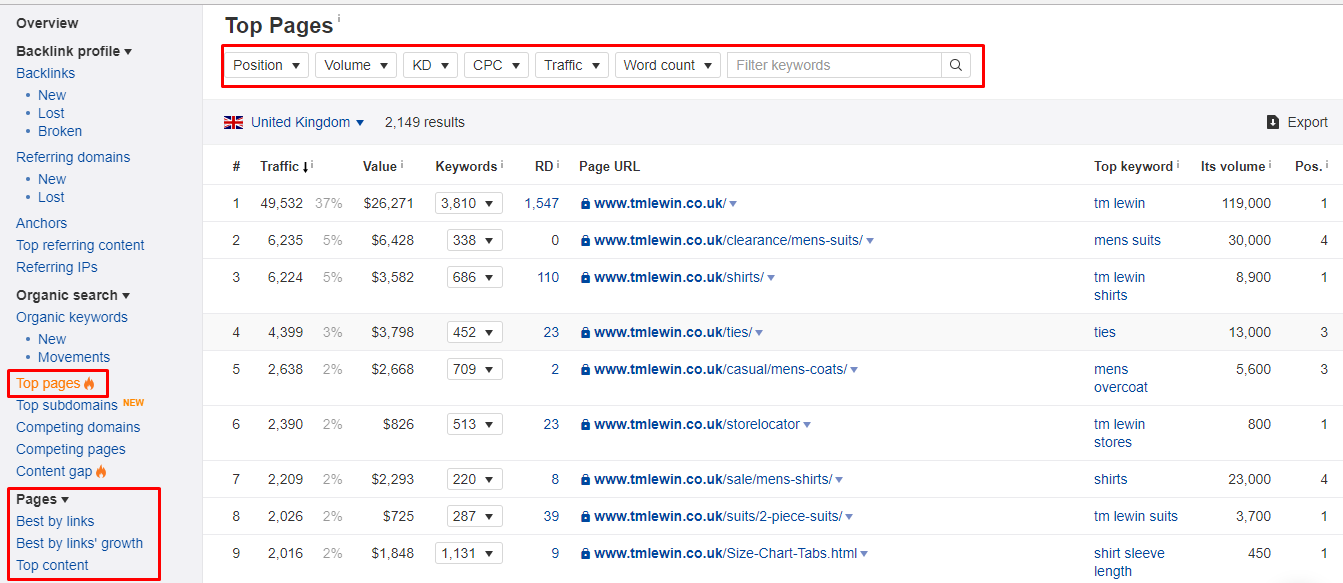
Part 3 – Download & Refine Data Further
Once you’ve got the data, I recommend downloading this into a spreadsheet, this simply makes analysing and building out a to-do list a bit easier.
Whether you used the best-by-links feature or the top-pages feature inside Ahrefs, you’re going to be left with a number of URL’s and the data associated with those URL’s.
One of the reasons why I recommended filtering the results depending on your timeline is due to the actual implementation of part 4.
Part 4 – Implementing internal links
Depending on how well you know your site depends on how quickly you can implement this. Personally I like being very detailed during our look-through of core content and slightly quicker as we go through the list (to less powerful pages on the domain).
All we’re doing in this stage is going through each live URL and determining where we would place an internal link. But please, please remember the 2 keys.
There’s 2 keys to remember during implementation:
- Based on your higher ranking competitors determines how aggressive you can go with your internal anchor text. If it’s similar to the 2 above examples, we know that we can go almost 100% exact match with our internal anchors.
- Searcher Intent – Remember if our end goal is to get people to buy shirts & clothing (in our TM Lewin example) then we shouldn’t be linking to content pieces FROM category pages and passing users and link juice away from these core converting pages.
A quick example:
For example a page such as: https://www.tmlewin.co.uk/The-Shirt-Page.html – Which contains some really useful content on a shirt’s sizing in a well designed and formatted way, could be built out incredible well into a huge linkable piece of content. Which then of course you’d then generate links to.
This piece could then contain multiple internal links to the different types of shirt pages (with exact match anchors), hence passing a lot of powerful link juice through to some of their highly commercial terms and pages.
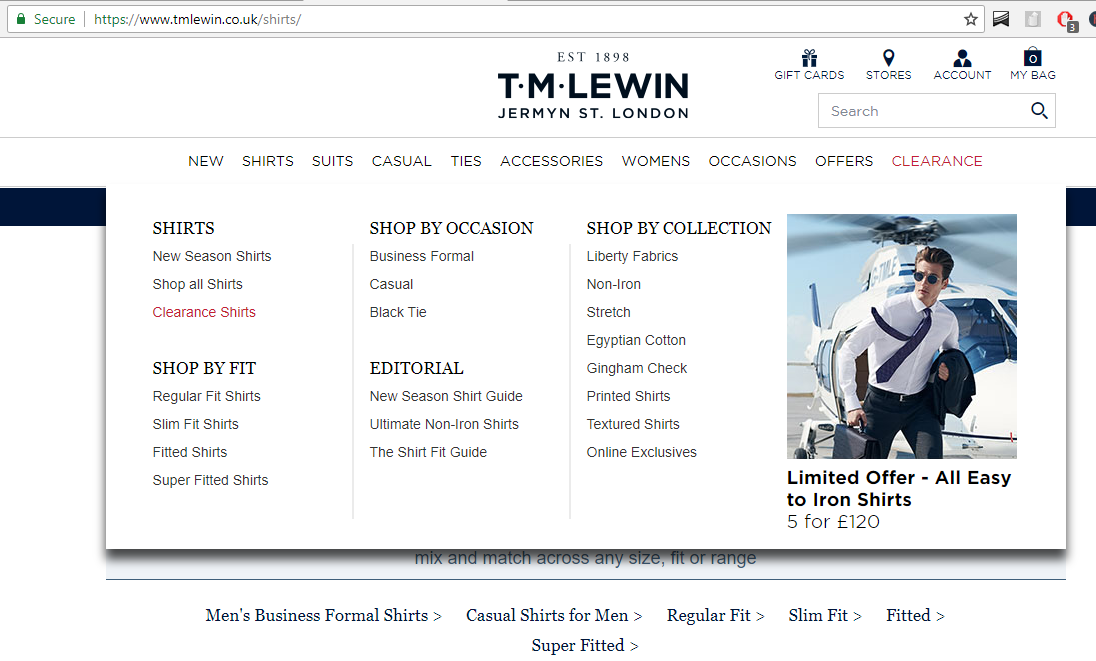
This in essence is how a real link building service should be leveraged the most. Having one piece of content generate an incredible amount of links, followed by internal linking leveraging this power and distributing the link juice to the most important, commercial terms on a site. This is also how you leverage link building on a budget too.
Conclusion
Internal linking is incredibly powerful and should be something you take advantage of. With the multiple tools and services on the market, it’s something that has a very good time to profit ratio. If you have any questions about a link building service, internal linking or anything SEO related, do not hesitate to get in touch with a member of the team today.
Thanks,
